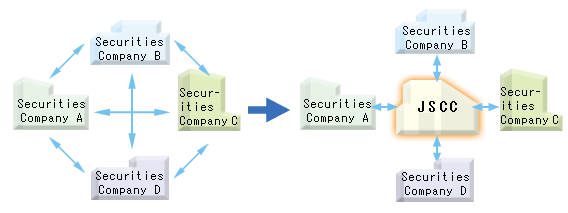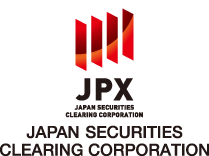Assumption of ObligationAssumption of Obligation
Financial Instruments Obligation Assumption Business
- On the trading of securities such as stocks and bonds, etc. a business to assume obligations that arise in such trading is called “Financial Instruments Obligation Assumption Business”; and an institution that undertakes such business is called “Financial Instruments Clearing Institution”. A clearing institution such as JSCC is called the “central counterparty” (CCP) since it interposes itself between parties to the transaction and becomes the counterparty to the buyer and seller by undertaking “Financial Instruments Obligation Assumption Business”.
- While Financial Instruments Obligation Assumption Business must be conducted by a joint stock company that is licensed by the Prime Minister (Financial Instruments and Exchange Law, Article156-2), JSCC was licensed to conduct the Securities Obligation Assumption Business (Financial Instruments Obligation Assumption Business under the current law) for the first time in Japan on January 7, 2003, and commenced its operations on January 14 of the same year.
- JSCC stipulates the criteria for the qualifications to become Clearing Participants, to whom JSCC acts as the counterparty of the obligations. In addition, JSCC establishes a scheme to guarantee settlements in place as well as performs the DVP (Delivery Versus Payment) settlement between Clearing Participants and JSCC.
Illustration with example
- When securities are traded, the seller incurs the obligation to deliver the securities and acquires the claim to receive payment. The buyer incurs the obligation to make payment and acquires the claim to receive the securities. (See Example 1)
<Example 1>
On April 1 , Securities Company A sells 1,000 shares of Company X to Securities Company B at ¥100 per share. On the settlement day of April 3 , Securities Company A delivers 1,000 shares of Company X to Securities Company B, which in turn pays ¥100,000 (= ¥100 x 1,000 shares) to Securities Company A.

- However, in the case where the buyer does not complete the payment even if the seller delivers the shares to the buyer on the scheduled settlement day, that seller is left without receiving the payment (see Example 2). On the other hand, in the case where the seller does not deliver the securities even if the buyer completes the payment to the seller on the scheduled settlement day, that buyer is left without receiving the shares. In this manner, when transactions are settled between the individual parties, each party bears the credit risk of its counterparty.
<Example 2>
In Example 1, Securities Company A delivers the shares of Company X to Securities Company B on April 3 . Securities Company B, however, has fallen into bankruptcy and is unable to make payment, leaving Securities Company A without receiving the payment of ¥100,000.

- Since large number of trades are continuously executed among multiple buyers and sellers in the securities market, should each transaction be settled individually between the counterparties concerned, you would have to incur the credit risk which increases in proportion to the number of counterparties as well as the heavy clerical burden arising from individual transaction. On the other hand, when an highly credible institution, acting as the counterparty of the transaction and conducting obligation assumption, interposes itself between the buyer and seller and guarantees the settlement by assuming obligations for both parties as well as acquiring the corresponding claims (see Example 3), the individual parties to the transactions are able to carry out trading without being concerned about the individual credit risks of the original counterparty.
<Example 3>
(1) In the case where Securities Company A sells 1,000 shares of Company X at ¥100 per share to Securities Company B, Securities Company A incurs the obligation to deliver 1,000 shares of Company X and acquires the claim to receive payment of ¥100,000. On the other hand, Securities Company B incurs the obligation to pay ¥100,000 and the acquires claim to receive 1,000 shares of Company X.
(2) JSCC assumes the obligation of Securities Company A to deliver 1,000 shares of Company X to Securities Company B, and newly acquires the claim to receive 1,000 shares of Company X from Securities Company A. For Securities Company B, JSCC assumes the obligation of Securities Company B to pay ¥100,000 as the payment for the 1,000 shares of Company X to Securities Company A, and newly acquires the claim to receive ¥100,000 from Securities Company B. That is, JSCC substitutes itself for Securities Company A and delivers the Company X shares, which JSCC receives from Securities Company A, to Securities Company B. At the same time, JSCC substitutes itself for Securities Company B and completes the payment, which JSCC receives from Securities Company B, to Securities Company A.
(1) Trade execution

(2) Assumption of obligations by JSCC

- Moreover, the unification of access points, which is realized by unifying the multiple number of settlement counterparties under one organization leads to the reduction of the administrative workload in the settlement process (see Example 4). Furthermore, this unification boosts offsetting effect on settlement volume because of the netting, which is carried out to settle only the difference between the buying and selling volume, thus allowing for more efficient use of funds and securities.
<Example 4> Concept of access point unification




